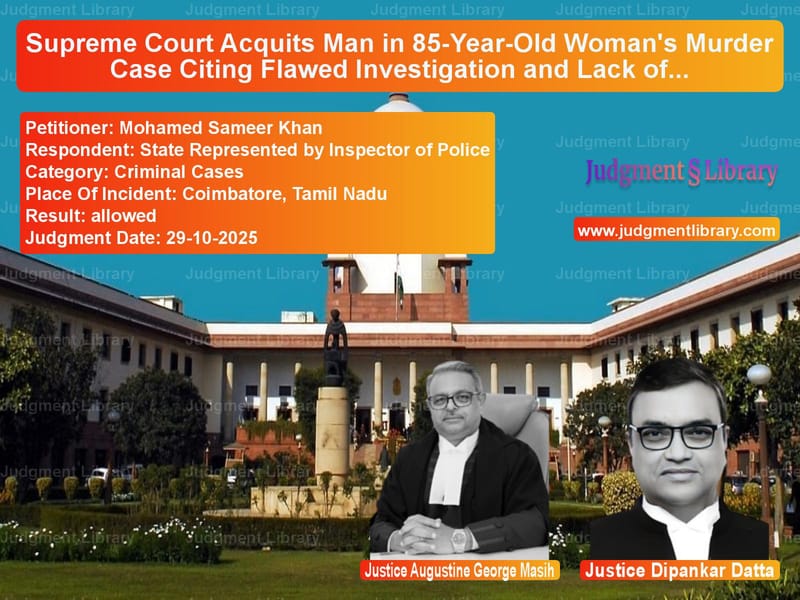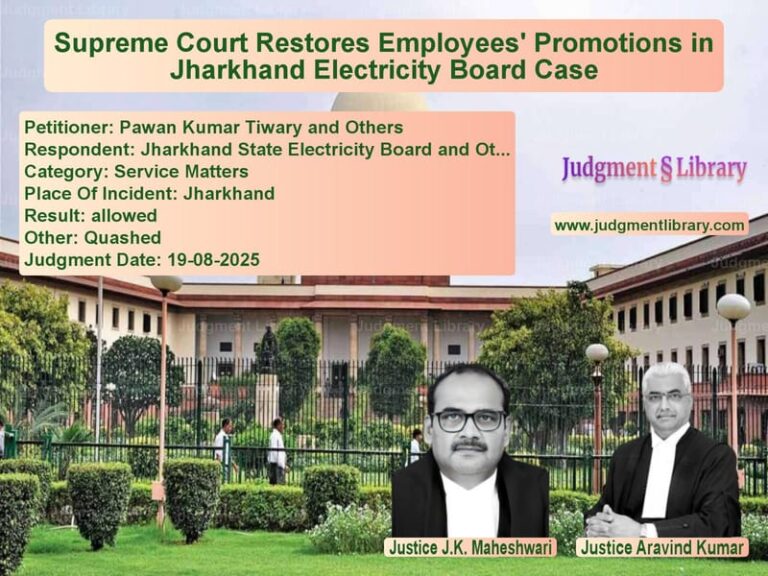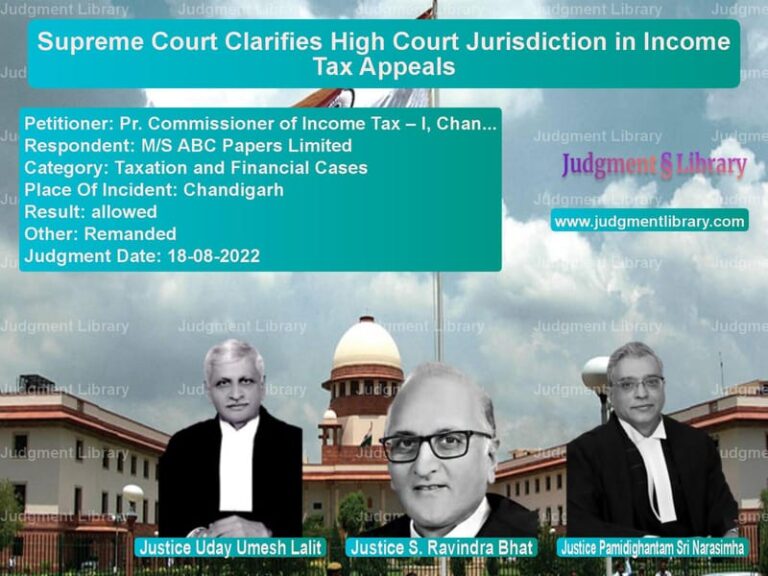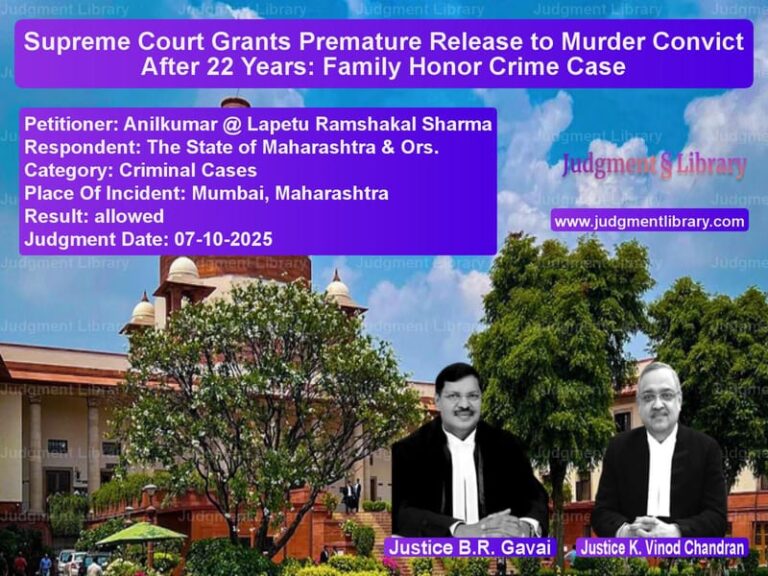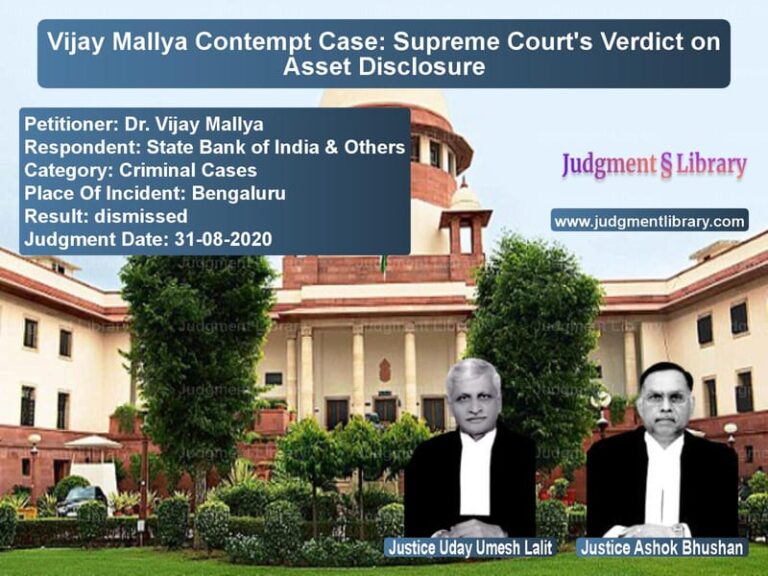Supreme Court Acquits Man in 85-Year-Old Woman’s Murder Case Citing Flawed Investigation and Lack of Evidence
In a landmark judgment that underscores the fundamental principle of ‘proof beyond reasonable doubt’ in criminal jurisprudence, the Supreme Court of India has acquitted Mohamed Sameer Khan of all charges in the brutal 2016 murder, rape, and robbery of an 85-year-old woman in Coimbatore. The judgment, delivered on October 29, 2025, exposes critical flaws in the investigation and highlights the dangers of convicting individuals based solely on circumstantial evidence without a complete chain of events pointing unequivocally to guilt.
The case dates back to December 19, 2016, when the 85-year-old victim was found dead in her home in Coimbatore. Her grandson discovered her body at 5:30 AM with a towel around her neck and two gold bangles missing from her hands. The post-mortem examination revealed she had been sexually assaulted and died from asphyxiation due to compression on her neck. The investigation that followed would eventually lead to the conviction of Mohamed Sameer Khan, a man from Manipur who had recently arrived in the area, but the Supreme Court’s judgment reveals how that conviction was built on shaky ground.
The Legal Battle
The appellant’s counsel made several crucial arguments challenging the conviction: ‘Learned Senior Counsel for the Appellant has asserted that the case of the prosecution is based upon circumstantial evidence. There is no direct evidence specifically connecting the appellant with the offence for which he had been accused. Her further submission is that the Appellant is falsely implicated. The prosecution has failed to establish the guilt of the Appellant beyond reasonable doubt and has also not probed in the right direction to find out the truth. No scientific evidence has been led connecting the Appellant with the crime, and some important and relevant persons who would have shed light on the incident have neither been associated in the investigation nor produced in the court.’
On the other side, the prosecution maintained that they had built a strong case: ‘On the other hand, learned Senior Counsel for the Respondent-State has submitted that there are concurrent findings returned by the courts below holding the Appellant guilty of the offences for which he was charged and punishment has been handed out in accordance with law. It has further been submitted that the prosecution has been able to prove the case on the basis of circumstantial evidence leaving no unbroken link in string of events which pinned down the Appellant to be the person who had committed the offences. Recovery has been effected from the Appellant of the two (2) gold bangles worn by the deceased which he had taken after murdering her.’
The Court’s Analysis of Circumstantial Evidence
The Supreme Court began its analysis by emphasizing the established legal principles for cases based on circumstantial evidence. Quoting from previous judgments, the Court laid down the fundamental requirements: ‘It is now well settled that with a view to base a conviction on circumstantial evidence, the prosecution must establish all the pieces of incriminating circumstances by reliable and clinching evidence and the circumstances so proved must form such a chain of events as would permit no conclusion other than one of guilt of the accused. The circumstances cannot be on any other hypothesis. It is also well settled that suspicion, however grave it may be, cannot be a substitute for a proof and the courts shall take utmost precaution in finding an accused guilty only on the basis of the circumstantial evidence.’
The Court further elaborated on these principles: ‘Thus, these basic established principles can be summarised in the following terms that the chain of events needs to be so established that the court has no option but to come to one and only one conclusion i.e. the guilt of the accused person. If an iota of doubt creeps in at any stage in the sequence of events, the benefit thereof should flow to the accused. Mere suspicion alone, irrespective of the fact that it is very strong, cannot be a substitute for a proof. The chain of circumstances must be so complete that they lead to only one conclusion, that is, the guilt of the accused.’
Critical Flaws in the Investigation
The Court identified several serious deficiencies in the prosecution’s case that created reasonable doubt about the appellant’s guilt.
One of the most significant issues was the investigation’s failure to examine Marcus, who had been with the appellant just before the crime: ‘In this light, an aspect, which marks itself as a contradiction and may cast doubt on the efficiency, sincerity and fairness of the investigation is the non-recording of the statement of Marcus, who is the person, who had been with the Appellant and had last seen him. Both of them came out of the house to smoke after the party was over at 2:00 a.m. His statement was not recorded nor was he associated with the inquiry or the investigation. Strangely, explanation of the prosecution in this regard is that he was not a material witness. This creates a doubt as he could be a suspect and in any case the person who would have indicated as to how long he and the Appellant were together, throwing some light as to whether the Appellant had the opportunity or time to go to the site of incident and/or commit such an offence.’
The Court found this omission particularly troubling given that Marcus was familiar with the area while the appellant had only arrived two days earlier: ‘The benefit of doubt with regard to this has to be given to the accused.’
Doubtful Arrest and Recovery
The circumstances of the appellant’s arrest also raised serious questions. The prosecution claimed that an unidentified informant pointed out the appellant at 4:00 AM on December 22, 2016, and that the appellant jumped from an over-bridge upon seeing police, injuring his leg. However, the Court noted: ‘Nothing has come on record, either in the form of any document or in the statement of any of the witnesses including the investigating officer with regard to the identity of the informant. The said informant’s statement has also not been recorded by the investigating officer nor has he been produced as a witness.’
This cast doubt on the entire arrest narrative: ‘In this light, the prosecution story regarding the Appellant being found at the over-bridge of North Coimbatore and arrested in the hospital becomes doubtful. Rather, the stand of the Appellant with regard to he having been taken into custody earlier and tortured could be a possibility.’
The recovery of the gold bangles was similarly questionable: ‘It appears to be unreasonable that the Appellant would be carrying the bangles with him at these odd hours i.e. 4:00 a.m., and that too, two days after the incident. Therefore, planting of the gold bangles upon the Appellant cannot be ruled out, casting serious doubt upon the alleged recovery.’
Lack of Forensic Evidence
Despite the presence of fingerprint experts and sniffer dogs at the crime scene, the prosecution failed to produce any scientific evidence connecting the appellant to the crime. The Court observed: ‘No hair or skin sample has been collected from the site which would connect the Appellant in any manner with the place of the incident or the offence. Merely because the medical evidence proves the unfortunate loss of life would not be enough to convict a person since he happened to be in the vicinity. In the absence of any forensic evidence when there is no eyewitness and the case is of circumstantial evidence, benefit would go to the accused.’
The Court further noted: ‘Nothing has come on record which would indicate any fingerprint of the Appellant having been found at the place of occurrence. The sniffer dog has also not been able to guide them to the house where the Appellant was residing.’
The Last Seen Theory
The prosecution relied heavily on the testimony of Senthil Kumar (PW-5), who claimed to have seen the appellant coming out of the compound where the deceased lived around 2:45 AM. However, the Court found this evidence insufficient: ‘What is significant to note is that it was not said that he was going out of the house of the deceased, but that he was seen going out of the compound. Further, Senthil Kumar’s testimony does not indicate that the Appellant looked nervous or shaky, in contrast to the testimony of Akash Saksena (PW-6), who stated so.’
The Court found the appellant’s calm behavior inconsistent with having just committed such a brutal crime: ‘In light of the fact that it has not come on record that the Appellant was in any manner involved in any other offence anywhere, his calm and composed response to the question put to him by Senthil Kumar, a stranger, without getting perturbed and that too right after having committed a gruesome crime appears to be unnatural.’
The Final Judgment
After meticulously examining all the evidence, the Supreme Court concluded that the prosecution had failed to meet the high standard required for conviction in circumstantial evidence cases. The Court invoked the principle from Kali Ram v. State of Himachal Pradesh: ‘it has been held that in cases wherein the guilt of the accused is sought to be established by circumstantial evidence, if two views are possible on the evidence adduced in the case, one pointing to the guilt of the accused and the other to his innocence, the view which is favourable to the accused should be adopted.’
The Court’s final conclusion was unequivocal: ‘The prosecution has failed to bring forth reliable evidence forming a complete string of events, leading to the guilt of the Appellant. The chain of events being sought to be projected is laden with deficiencies creating significant gaps, leading to other possible hypotheses as aforementioned. Due to such missing links, a finding of guilt cannot be recorded. The benefit of the doubt with regard to this must flow to the accused. In this light, the guilt of the accused has not been proved beyond reasonable doubt and the impugned judgments are, thus, liable to be set aside.’
The Court allowed the appeal, set aside the convictions, and ordered the immediate release of Mohamed Sameer Khan from Central Prison Kovai in Coimbatore, unless required in any other case.
This judgment serves as a powerful reminder of the fundamental principles of criminal justice – that it is better for ten guilty persons to go free than for one innocent person to be convicted. The Court’s meticulous examination of the evidence and its insistence on proper investigative procedures reinforces the constitutional protection available to every accused person and the heavy burden that rests on the prosecution to prove guilt beyond reasonable doubt, especially in cases relying solely on circumstantial evidence.
Petitioner Name: Mohamed Sameer Khan.Respondent Name: State Represented by Inspector of Police.Judgment By: Justice Augustine George Masih, Justice Dipankar Datta.Place Of Incident: Coimbatore, Tamil Nadu.Judgment Date: 29-10-2025.Result: allowed.
Don’t miss out on the full details! Download the complete judgment in PDF format below and gain valuable insights instantly!
Download Judgment: mohamed-sameer-khan-vs-state-represented-by-supreme-court-of-india-judgment-dated-29-10-2025.pdf
Directly Download Judgment: Directly download this Judgment
See all petitions in Murder Cases
See all petitions in Rape Cases
See all petitions in Custodial Deaths and Police Misconduct
See all petitions in Judgment by Augustine George Masih
See all petitions in Judgment by Dipankar Datta
See all petitions in allowed
See all petitions in supreme court of India judgments October 2025
See all petitions in 2025 judgments
See all posts in Criminal Cases Category
See all allowed petitions in Criminal Cases Category
See all Dismissed petitions in Criminal Cases Category
See all partially allowed petitions in Criminal Cases Category

